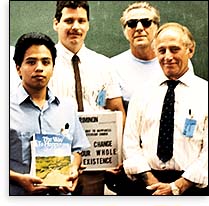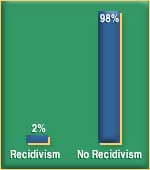

By Robert Godina


merica is besieged by a wave of violent crime. Politicians posture on the subject and vote for more prisons — the “steel-door syndrome,” as it has come to be known.
Law enforcement — from the beat cop to the commissioner — despair of any let up in the tidal wave.
The statistics are horrifying:
- The FBI reports that violent crime has tripled in the last 30 years.
- One million Americans are now in jail.
That is the equivalent of having the entire population of Dallas, Texas, in jail, supported by the rest of the country.
- More than 60 percent of those million prisoners are there for the second time. Every one of them learned hard lessons in jail, but not how to stay out.
- To keep one person in jail costs $25,000 a year — and the taxpayer gets nothing in return but more crime and more prisoners.
The recidivism rate looms as proof that the billions of dollars poured into the psychiatric-oriented so-called rehabilitation programs have been wasted.
A 1994 report of the National Council on Crime and Delinquency in America concluded that there was “little evidence that either institutional programs or noninstitutional efforts to rehabilitate offenders make any appreciable difference.” And so go the revolving doors of the U.S. penal system.
Fortunately for society, it is not a subject he avoided. From his research into the social ills plaguing society — research which was a natural outgrowth of his investigations into the mind and life that resulted in his discovery and development of Dianetics and Scientology — came the simple and powerful program called Criminon.
 Psychiatry’s Failure:
Psychiatry’s Failure:
|
 Criminon’s Results:
Criminon’s Results:
The results of the Criminon program tell the story. In a Butler Country, Alabama, study of juvenile offenders who compledted just part of the program, only 2 percent of the pilot group were recidivist; of a comparable control group not on the program, the usual 80 percent were recidivist. |
Meaning “without crime,” the first Criminon program opened in New Zealand in 1970. Growing out of the worldwide Narconon Drug Rehabilitation program (also based on Mr. Hubbard’s revolutionary breakthroughs that totally resolve this immense problem), Criminon operates within the penal system to truly rehabilitate criminals — to restore their sense of worth so that they once again become productive members of society.
The Criminon program moves the entire field of criminal rehabilitation from a cliché on the lips of politicians into the realm of demonstrable reality. And it is startling in its simplicity — it requires only the application of a few basic principles to bring about true and lasting reform of a criminal.
The results of the Criminon program tell the story. In a Butler County, Alabama, study of juvenile offenders who completed just part of the program, only 2 percent of the pilot group were recidivist; of a comparable control group not on the program, the usual 80 percent were recidivist.
Psychiatry’s Failures in the Prisons
That methods of reform currently used in prisons have proven ineffective is to understate the situation; in fact, they are demonstrably worsening the problems they are intended to resolve. Based on a psychiatric concept that man is yet another stimulus-response creature, created by his environment and unable to escape its tyranny and thus incapable of real change, these methods have only served to further dehumanize and psychologically damage prisoners.
“The search for a ‘cure’ for the criminal has sometimes even taken us beyond the bounds of civilized treatment,” wrote Norval Morris, professor of law and criminology at the University of Chicago, and James Jacobs, research fellow at the Center for Studies in Criminal Justice.
Conventional psychiatric treatments — addictive mind-altering drugs, electric shock, aversion “therapy,” sterilization and even psychosurgery — do change prisoners’ behavior, the researchers say, but for the worse. “The prisoner’s hostility and aggression are often increased when subjected to such treatments,” wrote Morris and Jacobs.
That the public is aware of the desperate need to reduce violent crime became obvious in recent elections. Poll-driven congressional candidates stumbled over each other to assure a concerned citizenry that they would “get tough” on crime. Unfortunately, this banal catch phrase usually means more money poured into these destructive methods.
Richard Stratton, editor of Prison Life magazine, states, “The get-tough-on-crime attitudes of the ’80s have given us rampant, desperate inner-city crime and violence in the ’90s. If we continue with our vengeful attitude toward criminals (poor minorities, the mentally ill, those who have nothing to lose), the violence will only get worse until there is an all-out war between the haves and the have-nots.”
The Criminon Solution
The Criminon solution to the seemingly impenetrable rock of criminality is based on simple and straightforward truths about the mind and the human spirit. It is the antithesis of vicious and destructive psychiatric approaches and addresses the individual and his personal integrity.
Mr. Hubbard once said, “Only that individual who has lost his pride of goodness, and his own pride of being, and his own honor, is dangerous. Because after that it doesn’t matter what he does to anyone, including himself.”
Thus, the Criminon program enables the individual to regain his pride of goodness, his own pride of being and his honor.
Criminon does not drug inmates. It does not use punitive restraints. It does not use aimless conversation for lack of a better tool. It is not psychiatry or psychology, which have no knowledge of what makes a criminal and thus no workable solutions.
Mr. Hubbard extensively researched criminality until he found its actual source:
“Do you know that there is not a criminal anywhere in any prison who is not a criminal because he was degraded and lost his personal pride?” Mr. Hubbard asked in a lecture. “I have done a very thorough cross-check of this — what they call ‘bad women,’ ‘criminal men.’ Their badness and criminality is immediately traceable to a loss of their powers and personal pride, and after they were ‘bad’ they were ‘dangerous.’
“If you want to rehabilitate a criminal, just go back and find out when he did lose his personal pride. Rehabilitate that one point and you don’t have a criminal anymore.”
The Criminon program is built on this basic understanding of the actual causes and cures for criminality.
The Criminon Program
One of Criminon’s primary tools for achieving this rehabilitation is The Way to Happiness Course, based on the booklet of that title written by Mr. Hubbard in 1980. This first step toward rehabilitation gives the prisoner, called a student once he is in the program, a knowledge of right and wrong. A non-religious, common-sense moral code, The Way to Happiness is practical and incisive and provides guidelines for behavior, missing in the life of many criminals.
Just this step alone has created astonishing results. In the Alabama study that showed juvenile recidivism go from 80 percent to 2 percent, the juveniles had completed only the first step of the program, The Way to Happiness component. Danny O. Black, director of the juvenile court and chief probation officer at that time, said, “Over 90 percent of the juvenile offenders seem to internalize the values and we don’t see them again as court referrals. ... I have over 500 letters on file that these kids have written saying how The Way to Happiness helped them straighten their lives out.”
Other courses in the Criminon lineup address vital yet often troublesome areas for the individual — how to learn, communication skills, personal values and integrity and other basics vital to successful living.
These include:
- The Learning Improvement Course. A high percentage of inmates are illiterate, and this course in study skills teaches the ability to learn any subject. Literacy is fundamental to any vocational and other training that will enable a reformed criminal to make a living from his own production.
- The Communication and Perception Course. These communication exercises increase the inmate’s ability to face life and not withdraw from it — the very act that precipitated the criminal condition.
- The Ups and Downs in Life Course. When an inmate is released from prison and returns to his previous environment, he often falls back into old patterns with former associates and ends up back in prison. The Ups and Downs in Life Course helps him learn the social and antisocial characteristics of his friends, family and associates and makes him much less susceptible to bad influences.
- The Personal Values and Integrity Course. This study of all aspects of an individual’s life and his personal ethics and integrity helps the inmate take responsibility for his past misdeeds rather than perpetuating them.
The comprehensive Criminon program totally replaces the unworkable rehabilitation methods that have only exacerbated crime. It directly rehabilitates individuals so the criminal behavior is laid to rest permanently.
Its effectiveness is causing the word about Criminon to spread rapidly.
Juvenile Hall Pilots
Criminon has established pilot programs in two juvenile halls, one in Los Angeles, the other in Northern California.
Those involved in the Los Angeles pilot are gang members facing charges of first-degree murder, accessory to murder, rape or other serious crimes. For these young but already hardened criminals, the Criminon program is their lifeline.
A warden in one of the units of the Los Angeles Juvenile Hall said that since the start of the program, he has seen a “dramatic change” in inmates on the program. “You can easily tell the difference between those on the Criminon program and those who aren’t,” he said. According to the warden, those on the program have hope that there is a possibility for them to leave the prison system and return to society. Many prisoners even voice remorse for having committed violent crimes, when earlier they asserted that their acts were wholly justified. They now say that they never want to commit such acts again and that they no longer wish to belong in gangs.
Grass-Roots Explosion
Based in Los Angeles, Criminon started delivering correspondence courses to inmates in four U.S. prisons in 1989. Since then, predominantly through inmates themselves spreading word of the program, Criminon correspondence courses have spread to more than 300 prisons and to every state.
Criminon is served by a volunteer pool of more than 100 course instructors. Since its inception, thousands of prisoners throughout the United States and Canada have been through the program and credit it with changing their lives.
An inmate in Canada said, “I received the book and the The Way to Happiness course from Criminon. For many years I seemed to be living in a very dark room. When I completed the course, it was like someone had switched the light on in this dark room and I beheld some pretty good things in there. I saw kindness, love, respect, self-control, honesty and many, many more beautiful things.
“Before I started this course, I had a low self-esteem and no pride within myself. Thanks to the above and the material in the course booklet, I have a new look on life. Things that I had taken for granted in life are so precious. This course has opened up my eyes and touched my heart. Now I am on my way down life’s road to happiness.”
An inmate from Indiana stated, “This course has changed my whole life. I don’t hate myself anymore and I look at life from a different view. It gave me self-esteem back and taught me how to take care of myself. It gave me a different outlook at other people. I used to think everybody in the world was against me, now I know that there are a lot of people out there who really care and want to help. I would recommend this course to anyone who really wants to change their life. ... I thought I could never change my life. I’m doing 20 years in prison right now and I know when I get out I’m not coming back.”
An Arizona prisoner wrote after completing The Way to Happiness Course: “This has helped me in many ways. I have a different outlook on life and people, and I have learned much more about moral values and how to apply them to my life. I feel that I can return to society to do what is right and help others, and I owe it all to your course. Thank you very much for caring to help me change my life, and for loaning me the tools for me to change, to become that better person.”
Families of prisoners are also seeing the direct results of the program in their estranged loved ones. Recently a woman in Glendale, California, called into a cable television show to praise Criminon for getting her son back. She said that while in prison, her son had done The Way to Happiness Course and as a result had become much calmer, much more concerned about other members of the family and had decided not to mix with his old group of drug dealers and other criminals.
Joan Lonstein, director of Criminon for the Western United States, commented on the desire among prison inmates for the Criminon program. “Many of these people have been rejected by the system,” she said. “Many are illiterate and have been labeled by the system as not wanting to learn, as not educable. From my experience this is not true. The inmates on our courses possess a hunger for learning which grows as they progress.”
Lonstein says it is a challenge for her corps of volunteers to meet the extraordinary demand for the program. The materials are made available to the prisoner free of charge, provided by donations.
Criminon receives major assistance from individual members of the Church of Scientology, who have donated substantial time and money to assist in the rehabilitation of criminals and to bring about a saner and safer environment.
Official Recognition
Observing the results of Criminon and the failure of other attempts at reform, more and more correctional facilities are reaching for this solution.
Recently, several prisons in Mexico authorized the construction of facilities and the training of staff for both Criminon and the Narconon drug rehabilitation programs. Because 80 percent of prisoners in these facilities currently use drugs, both criminal reform and drug rehabilitation programs are vital.
As a result of Criminon’s successes, correctional facilities in the United States have made similar approaches to Criminon International for assistance in implementing the program in their facilities.
Criminon is expanding internationally and will continue to do so for the simple reason that it works. The cost of putting an inmate through a Criminon course is about $170, compared to the mammoth costs of other, unsuccessful programs, to say nothing of the secondary costs to society of releasing unreformed criminals.
Criminon is the alternative to those broad, ineffective methods of psychiatric rehabilitation. If a mere fraction of those wasted billions were put into this effective program, the revolving door would close forever.
For more information on the Criminon program, write to: Criminon, c/o Narconon International, 7060 Hollywood Blvd., Suite 220, Los Angeles, CA 90028.


 The FBI reports that violent crime has tripled in the last 30 years.
The FBI reports that violent crime has tripled in the last 30 years.